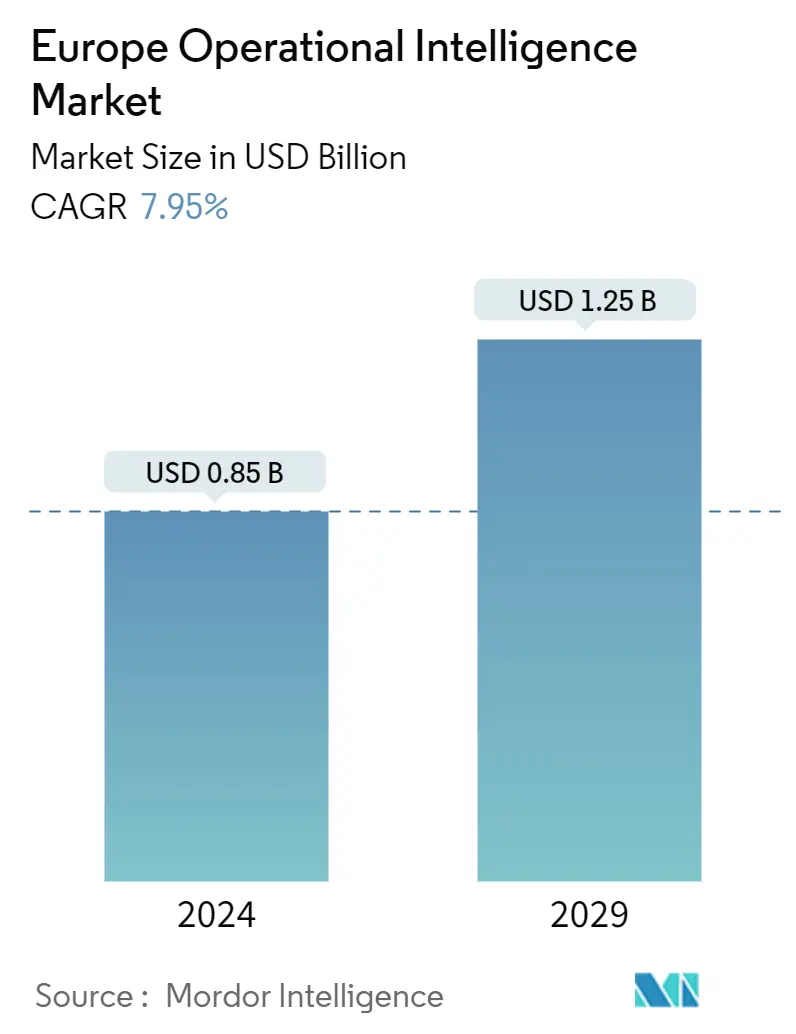Market Size of Europe Operational Intelligence Industry

| Study Period | 2019 - 2029 |
| Base Year For Estimation | 2023 |
| Market Size (2024) | USD 0.85 Billion |
| Market Size (2029) | USD 1.25 Billion |
| CAGR (2024 - 2029) | 7.95 % |
| Market Concentration | Low |
Major Players
*Disclaimer: Major Players sorted in no particular order |
Need a report that reflects how COVID-19 has impacted this market and its growth?
Europe Operational Intelligence Market Analysis
The Europe Operational Intelligence Market size is estimated at USD 0.85 billion in 2024, and is expected to reach USD 1.25 billion by 2029, growing at a CAGR of 7.95% during the forecast period (2024-2029).
The need for data quality control, data discovery, and data visualization is forcing companies to deploy operational intelligence software. On-premises ESB and BPM (Business Process Management) solutions are well suited for vertical scalability while integrating with an organization's complex internal systems and architectures.
- In Europe, various industries are adopting big data analytics and the Internet of Things (IoT), in turn propelling the growth of the operational intelligence market. However, the high cost of operational intelligence tools is restraining the operational intelligence market growth. The deployment of OI tools and their complex programming becomes a costly affair for business enterprises. As a result of factors like the high-cost factor and the requirement of skilled professionals to operate the software, the market growth could be better in the region.
- Many industries are spending on their digital infrastructures. Also, many European countries are investing heavily in their digital infrastructure. Still, private and public initiatives have been launched to fill the skills gap and accelerate the rate of cloud adoption. During the epidemic, 53% of enterprises in the European Union that had previously implemented advanced digital technology increased their investment in digitalization. This is compared to 34% of non-digital EU enterprises that used the crisis as an opportunity to begin investing in their digital transformation.
- Cloud adoption is expected to gain significant market share due to additional benefits such as scalability, cost-saving, accessibility, and centralized service.Europe had the highest adoption rate of cloud services. According to Eurostat, the region's statistics agency, there has been significant growth in businesses migrating to the cloud. In its published report "Cloud Computing Statistics on the Use by Enterprises" report, the agency reported the 23% EU-wide growth in businesses migrating to the cloud was led by Malta (65%), Cyprus (50%), Hungary (50%), Germany (45%), and the United Kingdom (45%). According to NetApp, the hybrid cloud infrastructure is Europe's most preferred cloud deployment method.
- Moreover, the major benefit of an OI implementation is that operational problems and opportunities can be addressed as they arise or even before they occur, as in predictive maintenance. Operational intelligence also enables business leaders and employees to make more informed and better decisions every day. Ultimately, increased visibility and insight into business operations, if managed properly, can lead to increased revenue and competitive advantage over competitors.
- The COVID-19 pandemic significantly impacted the European operational intelligence market. Many businesses faced disruptions and had to adapt their operations. Some sectors, like healthcare and logistics, saw increased demand for operational intelligence solutions to manage challenges. However, economic uncertainties led to budget constraints for technology investments in other industries.
